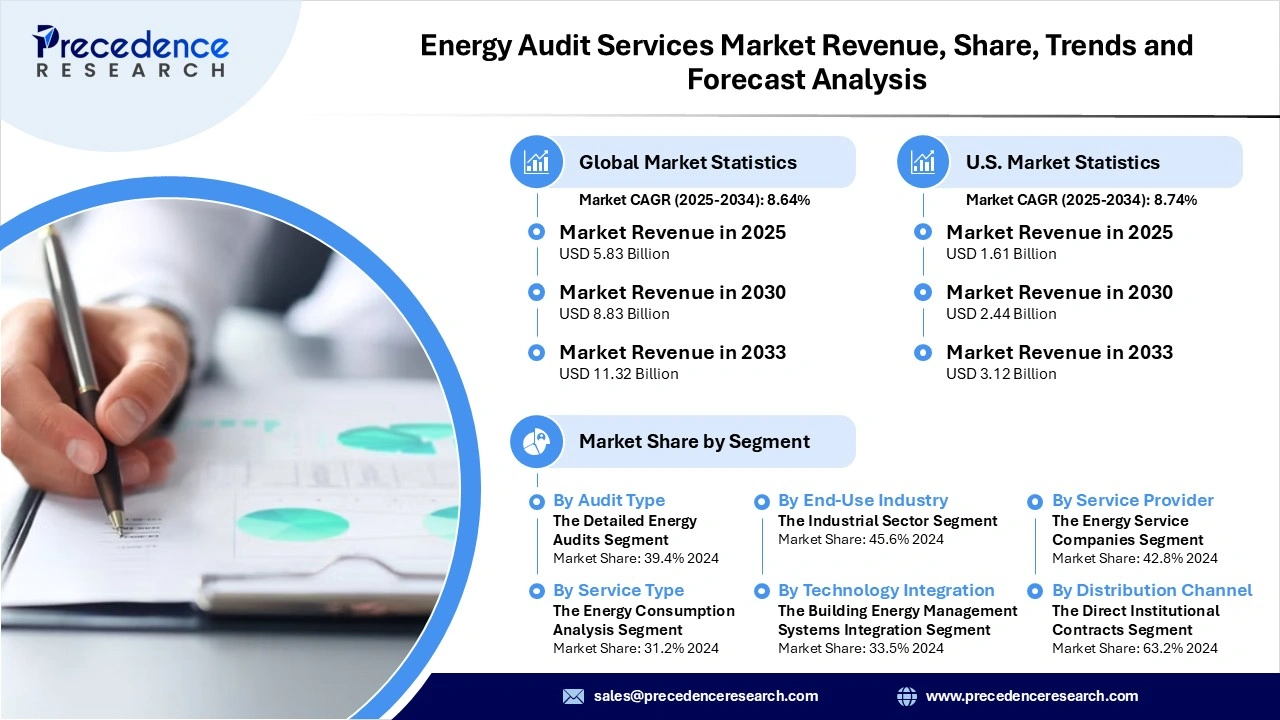November 2025
The global energy audit services market revenue was valued at USD 5.83 billion in 2025 and is expected to attain around USD 11.32 billion by 2033, growing at a CAGR of 8.64% during forecast period. The market is expanding due to several factors, including stringent environmental regulations, cost-saving goals, and an increasing emphasis on corporate sustainability to meet climate-saving targets.

The markets growth is primarily driven by stringent government regulations, such as the EU Energy Efficiency Directive, which requires enterprises to conduct energy audits to ensure compliance with carbon-emissions standards and energy-efficiency targets. Also, rising energy costs are a leading driver of market growth, enabling companies to reduce operational expenses through enhanced efficiency.
Energy audits are crucial because they help identify major inefficiencies, waste, and outdated equipment, leading to further cost savings on utility bills. By optimizing energy use, enterprises can improve profitability and gain a competitive edge. As many developing nations focus on industrialization and infrastructure development, demand for energy efficiency has surged. Improvements in technologies such as automation, data analytics, and AI are making energy audits highly precise, driving global market expansion.
North America held the largest market share in the energy audit services market due to several factors, including its strong influence on energy policies to curb carbon emissions, aggressive efforts to reduce carbon emissions and a burgeoning ecosystem backed by the U.S. DOE, with tax incentives and funds for energy-saving projects. The U.S. is a major contributor to regional market growth. Federal initiatives such as the Better Buildings Initiative, the Energy Star program and state-level mandates for commercial building benchmarking continue to increase demand for professional energy audits.
Utilities in states like California, New York and Massachusetts also provide rebates and performance-based incentives that encourage industrial facilities, campuses and commercial buildings to seek comprehensive audits. The presence of experienced engineering firms, advanced metering infrastructure and widespread adoption of building management systems further strengthen the growth of energy audit services across the region.
Asia Pacific is expected to witness the fastest CAGR during the forecast years as governments of leading countries like India, China and Japan are fiercely promoting energy conservation under rapid industrialization and flourishing urbanization, while maintaining carbon emissions at their lowest possible levels. Country-level targets, such as Carbon Neutral China by 2060, are further driving the region’s market growth.
National programs such as India’s Perform, Achieve and Trade (PAT) scheme and Japan’s Energy Conservation Act are accelerating mandatory and voluntary energy efficiency assessments across factories, public infrastructure and commercial buildings. Growing pressure on power grids, increasing energy costs and expanding manufacturing hubs across Southeast Asia are also pushing companies to adopt systematic energy audits to optimize operations. In addition, growing investments in green buildings and renewable energy integration support the long-term relevance of audit services across the region.
| Report Attribute | Key Statistics |
| Market Revenue in 2025 | USD 5.83 Billion |
| Market Revenue by 2033 | USD 11.32 Billion |
| CAGR from 2025 to 2033 | 8.64% |
| Quantitative Units | Revenue in USD million/billion, Volume in units |
| Largest Market | North America |
| Base Year | 2024 |
| Regions Covered | North America, Europe, Asia-Pacific, Latin America, and the Middle East & Africa |
Get this report to explore global market size, share, CAGR, and trends, featuring detailed segmental analysis and an insightful competitive landscape overview @ https://www.precedenceresearch.com/sample/7132
You can place an order or ask any questions, please feel free to contact us at sales@precedenceresearch.com |+1 804 441 9344
November 2025
October 2025
July 2025
July 2025